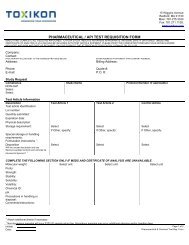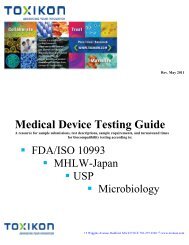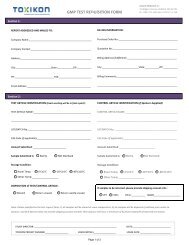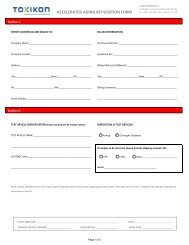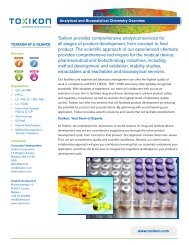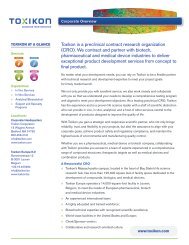Biocompatibility Safety Assessment of Medical Devices ... - Toxikon
Biocompatibility Safety Assessment of Medical Devices ... - Toxikon
Biocompatibility Safety Assessment of Medical Devices ... - Toxikon
Create successful ePaper yourself
Turn your PDF publications into a flip-book with our unique Google optimized e-Paper software.
ISO 10993-3 MHLW 2003<br />
Time point(s) <strong>of</strong><br />
assessment:<br />
Sufficient to achieve<br />
steady state (e.g. 2, 4, 6,<br />
and 12 weeks)<br />
Number <strong>of</strong> animals:<br />
At least three per time<br />
period <strong>of</strong> assessment<br />
Number <strong>of</strong> samples for<br />
evaluation<br />
At least eight per time<br />
period for test and control<br />
Evaluation criteria:<br />
Comparative evaluation<br />
<strong>of</strong> responses to test and<br />
control materials<br />
7 days and 4 weeks<br />
At least four per time period<br />
No minimum number specified<br />
If more than two <strong>of</strong> the four test sites in<br />
each animal exhibit a significant response<br />
compared control sites, the test is<br />
considered positive<br />
Table IX shows the differences between ISO 10993-6 and the MHLW guidelines for<br />
assessing the effects <strong>of</strong> device or material implantation.<br />
The major differences between the ISO and MHLW implantation guidelines are found in<br />
the procedures used to assess short-term effects <strong>of</strong> implantation. For long-term implant<br />
effects, MHLW concurs with ISO methodology. Major differences between the<br />
guidelines are illustrated in Table IX.<br />
EYE IRRITATION TEST<br />
Tests for assessing potential for eye irritation <strong>of</strong> test devices are required by ISO 10993-<br />
10, "Tests for Irritation and Sensitization," and Japan's MHLW. The protocols specified<br />
by the ISO standardand the MHLW guidelines are essentially similar and recommend<br />
that at least three rabbits be used per extract. A volume <strong>of</strong> 0.1 ml <strong>of</strong> the test material or its<br />
extract (polar or nonpolar) is instilled in one eye <strong>of</strong> each animal. The other eye receives<br />
the control vehicle or extractant. The test and control eyes are assessed for biological<br />
responses at 1, 24, 48, and 72 hours after instillation. The observation period need not<br />
exceed 21 days. The reactions <strong>of</strong> the test and control eyes are recorded and assessed using<br />
a specific classification scale described in the ISO 10993-10 standard.<br />
15



